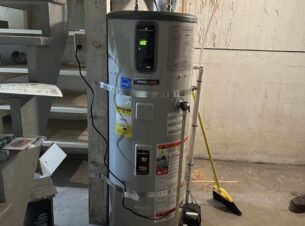Since opening its doors in 1873, YWCA Toronto has worked to improve the lives of women and girls by providing training, educational opportunities and housing, while advocating for systematic change. As part of this effort, the organization has recently completed construction of the YWCA Elm Centre, an $80 million, 302-unit affordable and supportive permanent housing complex for women and women-led families, located in the downtown Toronto core. The complex, designed by regional Architects with Hilditch Architects, opened in November of 2011. It spans an entire city block and includes 5-, 10- and 17-story residential towers, a restaurant, boutique, auditorium and other commercial space, as well as the new YWCA Toronto corporate offices.
The YWCA Elm Centre’s design incorporates a variety of sustainable construction elements, including: five green roofs, two rooftop gardens,outdoor community recreation space, an indoor waste sorter system for garbage, recyclables and compostables located on each residential floor and Energy Star-rated appliances in each residential unit.
Closely aligned with the City of Toronto’s energy efficiency and energy consumption targets, the building complex also features a multi-stage heat recovery system, and a geothermal water-to-water heat pump system integrated with an innovative thermally-activated slab radiant heating and cooling system manufactured by REHAU. The system, designed to deliver 3 million Btu/hr, is fed by a geothermal well field of 90 500-foot (152 m) deep vertical boreholes located under the parking garage structure.
“We selected this type of system as it is estimated to reduce carbon emissions by 415 tons—or 45%—per year,” said Alex Tan, P.Eng. (Project Engineer in-charge) of Lam & Associates, the project’s mechanical and electrical engineering firm, “which far exceeds the energy savings achieved when compared with conventional mechanical systems.”
Identified as highly compatible with a geothermal system in respect to its moderate fluid temperature requirements, a radiant system was also sought as the primary heating and cooling source in all three residential towers. Lam & Associates subsequently approached Klimatrol Environmental Systems, a Toronto-area specialist in radiant heating and cooling system design and supply, to assist on the project.

“We agreed that this was an excellent project in which to incorporate radiant heating,” said Mark Euteneier, president of Klimatrol Environmental Systems Ltd. “and were excited to take the project a step further by recommending a combined radiant heating and cooling system from REHAU.”
“We’ve represented REHAU radiant systems since 1994,” Euteneier continued, “and rely extensively on the company’s product development and engineering department to provide finite element analysis (FEA) calculations for our projects. The REHAU FEA modeling software recreates the floor structure positioning of pipes as specified to determine actual floor and ceiling output capacities. When designing floor heating and cooling systems, every project is unique in some way, and this critical information allows the mechanical consultant to correctly engineer a system that can effectively maintain optimum occupant comfort throughout both the heating and cooling seasons.”
“Requiring moderate fluid supply temperatures ranging from 90 to 110°F (32 to 43°C) in the heating mode and 58 to 65°F (14 to 18°C) in the cooling mode, a radiant system can be ideally integrated with a geothermal system, which typically supplies fluid temperatures below 120°F (49°C),” explained Tan. “Thus, we realized that specifying a radiant system for this particular project, which was centrally focused around a large-scale geothermal energy source, would further enhance the overall efficiency of the HVAC system.”
The system, which was designed by a team including Lam & Associates, Klimatrol and REHAU, featured an optimized thermally activated slab design.
According to Tan, the in-slab installation of a radiant system would provide additional benefits by increasing usable floor space in the residential units, and by eliminating the potential for damage to the floor registers or radiators associated with other types of HVAC systems. Also, as a non forced-air system, radiant heating would minimize the circulation of airborne particulates such as dust and other allergens.
 “With all mechanical equipment located outside the suites, except for a bathroom exhaust fan, residents are not exposed to HVAC equipment noise, nor is there need to worry about replacing air filters or fan belts,” Tan said. “Maintenance requirements are thus very minimal in the suites, which reduces overall building operation and maintenance costs – from labor all the way down to eliminating the purchase of 1,200 air filters each year.”
“With all mechanical equipment located outside the suites, except for a bathroom exhaust fan, residents are not exposed to HVAC equipment noise, nor is there need to worry about replacing air filters or fan belts,” Tan said. “Maintenance requirements are thus very minimal in the suites, which reduces overall building operation and maintenance costs – from labor all the way down to eliminating the purchase of 1,200 air filters each year.”
“Thermally activated slab designs, also known as thermally activated building systems (TABS) or thermally activated concrete, have increased in popularity due to a significant number of existing installations in other parts of the world, and particularly in Europe,” said Ryan Westlund, applications engineer at REHAU. “Also known as BKT in Germany and BATISO in areas like Switzerland, these systems are ideal in multi-level structures, where the same concrete slab can be activated for heating from the upper side, and cooling from the underside, depending on the time of year. European installations have offered proof to the North American construction industry that thermally activated slab designs can provide enhanced energy distribution in hydronic radiant applications. We are seeing more and more such applications in the U.S. and Canada.”
According to Lance MacNevin, REHAU Academy manager, in order to create a thermally activated slab, flexible yet strong crosslinked polyethylene (PEXa) pipe such as REHAU’s RAUPEX® is embedded in a series of circuits within the thermal mass of a building, constituted by the slabs between each level of the structure.
“This type of system includes all the basics of a uni-directional, conventional in-slab radiant floor heating system configuration,” MacNevin said. “Unlike a conventional radiant slab however, insulation is not used between internal levels of a building and suspended ceilings are removed, thus yielding an exposed concrete floor and ceiling. By facilitating the circulation of heated or cooled fluid through pipes embedded within the slab, and removing any added thermal resistance from plenum spaces associated with suspended ceilings, one can effectively create a radiant surface both above and below, while only requiring one layer of PEXa circuits per slab, usually spaced between 6 and 12 inches on-center.”
Also according to Westlund traditional radiant floor heating systems have fundamental advantages over ceiling heating installations due to the natural buoyancy of warm air, which directly improves a slab’s thermal output through an approximate 60-percent higher heat transfer coefficient for floor applications versus ceiling applications. This subsequently yields a greater system capacity, or associated heat flux from a warm surface to the conditioned space measured in Btu/hr∙ft2 or W/m2. The reverse is true for radiant cooling ceiling systems, where embedding the pipe to be used as a cooled ceiling surface yields an approximate 60-percent advantage in heat transfer coefficient compared to a chilled floor surface system. A thermally activated slab inherently uses both systems, maximizing the output of the ceilings and floors in either mode.
A comparison of traditional radiant floor heating and cooling system outputs versus those achievable with a thermally activated slab illustrate the potential benefits of this type of system. While a radiant floor system can achieve up to 32 Btu/hr∙ft2 (101 W/m2) in the heating mode and 16 Btu/hr∙ft2 (50 W/m2) in the cooling mode, both under ideal conditions, a thermally activated slab, because of its bidirectional output, can achieve output in the range of 50 Btu/hr∙ft2 (158 W/m2) in the heating mode, and 30 Btu/hr∙ft2 (95 W/m2) in the cooling mode.
The thermally activated slab system designed for Elm Centre was installed in a total of 212,000 square feet (20,000 m2) of floor area throughout each level of all three towers. A total of 236,000 feet (72,000 m) of 1/2-in. RAUPEX O2 Barrier pipe was used throughout the building, embedded in the center of each of the suspended 8-inch concrete slabs using an efficient pipe layout pattern.
“We used a counterflow spiral pipe loop design within each of the slabs to ensure even surface temperatures during both heating and cooling,” said Euteneier. “In our many years of supplying radiant systems, we’ve found this to be the most effective piping pattern for maximizing system control, achieving uniform surface temperatures and ultimately providing occupant comfort, and subsequently we incorporate it into all of our projects.”
According to Euteneier, the building was also designed to concentrate all the major pipes and ancillary ductwork of the building’s other systems into the structure’s core, which allowed for maximum exposure of each slab’s ceiling and floor surface.
A total of 110 5- to 12-circuit REHAU PRO-BALANCE® manifolds were installed in the corridor on every other floor of each building, inside mechanical cabinets that also house the system’s pumps and mixing valves. The manifolds’ circuit control valves allow for precise flow balancing to each circuit to match the zone’s heat load calculations, while low-voltage valve actuators provide electric flow control to each of the residential suites.
“To accommodate for the suspended slab design of the project, the PRO-BALANCE manifolds were used for temporary pressure tests onsite during the concrete pour, then mounted in their final positions in the mechanical cabinets and re-pressurized to ensure no leaks occurred throughout the entire construction process,” explained Euteneier.
The circuit/zone configuration of the radiant heating and cooling system also facilitated the ability for each suite to be individually controlled by thermostats integrated with the building automation system (BAS). Lam & Associates was able to configure the BAS in such a way as to “reverse” the thermostats based on the desire to either heat or cool the space. Thus, the thermostats would allow for occupant-dictated temperature-controlled cooling from the ceilings in summer, and heating from the floors in winter.
“Residents will undoubtedly experience maximized comfort in being able to adjust their individual suites for ideal warmer or cooler temperatures,” Euteneier said.
The BAS (building automation system) was additionally programmed with an algorithm to provide heat anticipation from weather changes that triggers automatic compensation for the thermal lag of the concrete slab. The energy consumption for the entire geothermal system, including the radiant in-slab system and vertical boreholes, are monitored by the BAS in real time, with data recorded every five minutes. This information is then compiled for reference in modeling and simulating future project designs.
To heat and chill the water circulating throughout the radiant heating and cooling system’s piping configuration, a 25-percent antifreeze fluid is fed from the water-to-water geothermal system’s braised plate stainless steel heat exchangers located in each mechanical cabinet.
Lam & Associates additionally designed a system of downsized ventilation ductwork leading to each residential suite in order to meet fresh air and ventilation requirements, while also dehumidifying the air and regulating surface dew points.
In total, the complete thermally activated slab system provides 300 tons of heating and cooling capacity, including for the office administration areas in the lower floors of the residential towers.




Join the conversation: